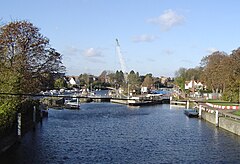| Teddington Lock | |
|---|---|
 Teddington Lock undergoing maintenance. From left to right – rollers, skiff lock, launch lock and barge lock | |
 | |
| 51°25′54″N 0°19′26″W / 51.43167°N 0.32389°W [2] | |
| Waterway | River Thames |
| Country | England |
| County | Greater London |
| Maintained by | Environment Agency |
| Operation |
|
| First built |
|
| Length |
|
| Width |
|
| Fall | 2.68 m (8 ft 10 in) [1] |
| Above sea level | 14 ft (4.3 m) |
| Teddington is normally staffed 24 hours a day | |
Teddington Lock and the Kingston-upon-Thames Reach | |||||||||||||||||||||||||||||||||||||||||||||||||||||||||||||||||||||||||||||||||||||||||||||||||||||||||||||||||||||||||||||||||||||||||||||||||||||||||||||||||||||||||||||||||||||||||||||||||||||||||||||||||||||||||||||
|---|---|---|---|---|---|---|---|---|---|---|---|---|---|---|---|---|---|---|---|---|---|---|---|---|---|---|---|---|---|---|---|---|---|---|---|---|---|---|---|---|---|---|---|---|---|---|---|---|---|---|---|---|---|---|---|---|---|---|---|---|---|---|---|---|---|---|---|---|---|---|---|---|---|---|---|---|---|---|---|---|---|---|---|---|---|---|---|---|---|---|---|---|---|---|---|---|---|---|---|---|---|---|---|---|---|---|---|---|---|---|---|---|---|---|---|---|---|---|---|---|---|---|---|---|---|---|---|---|---|---|---|---|---|---|---|---|---|---|---|---|---|---|---|---|---|---|---|---|---|---|---|---|---|---|---|---|---|---|---|---|---|---|---|---|---|---|---|---|---|---|---|---|---|---|---|---|---|---|---|---|---|---|---|---|---|---|---|---|---|---|---|---|---|---|---|---|---|---|---|---|---|---|---|---|---|---|---|---|---|---|---|---|---|---|---|---|---|---|---|---|---|
| |||||||||||||||||||||||||||||||||||||||||||||||||||||||||||||||||||||||||||||||||||||||||||||||||||||||||||||||||||||||||||||||||||||||||||||||||||||||||||||||||||||||||||||||||||||||||||||||||||||||||||||||||||||||||||||

Teddington Lock is a complex of three locks and a weir on the River Thames between Ham and Teddington in the London Borough of Richmond upon Thames, England. Historically in Middlesex, it was first built in 1810.
The limit of legal powers between the Port of London Authority, the navigation authority downstream to the North Sea and that upstream to small headwaters of the river, the Environment Agency, is marked nearby by an obelisk on the "Surrey" (towpath, right) bank.[n 1] The weir named Teddington Weir marks the river's usual tidal limit and is the lowest on the Thames. This lock is the lowest full-tide lock and second lowest of all-tide locks on the Thames.
The complex of civil engineering or infrastructure in essence consists of a large long weir and three locks: a conventional launch lock in regular use, very large barge lock and a small skiff lock. The barge lock was made to accommodate long barges, steamers or passenger ferries and has an additional set of gates half-way to operate more quickly for shorter craft. The staggered structures incorporate two reinforced narrow islands. The upper island is traversed by and accessible by the lock gates or Teddington Lock Footbridge.
- ^ a b c "A User's Guide to the River Thames" (PDF). PDF file. Environmental Agency. 2009. pp. 29–30. Retrieved 11 November 2012.
- ^ "Teddington Lock website". Retrieved 3 March 2017.
Cite error: There are <ref group=n> tags on this page, but the references will not show without a {{reflist|group=n}} template (see the help page).